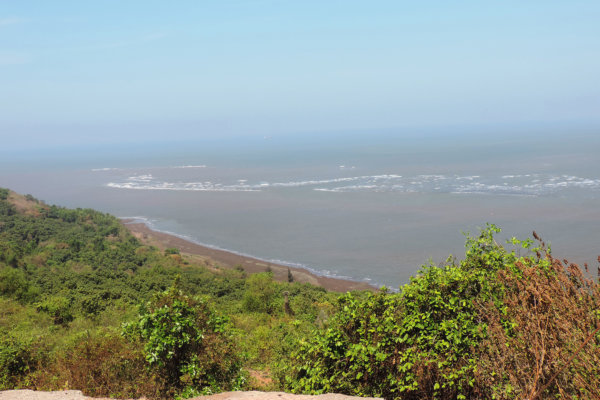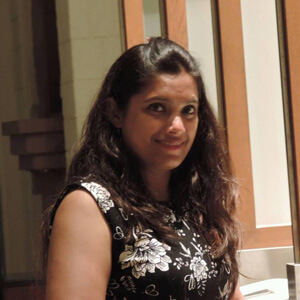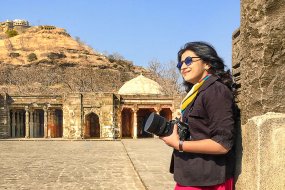Welcome little one…
Velas, Ratnagiri, March 2019
Watching wild life has always been a priority for me. When I heard about the Turtle festival, I was very curious. I read about the festival and enquired about it with my online resources. I was directed to a little village in Ratnagiri – Velas. I had never heard about this village earlier. And now this little settlement took center stage!
I contacted a person called Mandar. Mandar lives in Velas and hosts people like us who are interested in watching the little turtle eggs hatch and young ones walk to the sea. I was still not sure of the reason why they called it as a festival! For me festival was only Diwali, Durga Pooja and Ganesh festival. What was so special about Turtles and why was it a festival?
The day finally came. All planning had been done. Our accommodation booked at Mandar’s house. I was so surprised to hear the rates! I couldn’t imagine a trip that would be such a low budget affair.

We booked our self drive Scorpio from Zoom. These masters of self drive car have put up a very well thought of system and used technology to the best. A key less entry to our Scorpio seems near magical. Like Alibaba and the 40 thugs, we went near our car, pressed the unlock button and CLICK. The beast was unlocked. As I entered the car I was instructed about the documents, features, safety warnings and that was it, no person to deliver the car to me. No person to explain stuff to me. Everything automated and yet perfect to the T. I think Zoom have mastered the art of self drive car rentals. You will have zero scope to complain.
As our Scorpio took to the streets, excitement was in full force. It was a family picnic happening after a long time, exams and studies were over and vacation was in the air. We left from Baner in Pune and took the Sus Road to Pirangut where we joined the road to Mulshi and Tamhini Ghat. It was afternoon and the sun had already started its summer season. Hot and dry was the weather to welcome us. Although the AC was pretty powerful, it still could not beat the heat. To add to our worries, the road conditions in Tamhini Ghat are not too great. ‘Duniya ummeed pe jeetee hai…’ we are hopeful always that the next time around when we travel Tamhini Ghat, the road conditions would have improved. But hope remains hope and reality never comes even close to it.
Travelling through the beautiful forests of Tamhini, with a tall and sturdy Sahyadri on one side and the waters of Mulshi on the other we landed in Mangaon. From Mangaon we went towards Shrivardhan. At one juncture the road splits into two. The left goes towards Bagmandal ferry jetty and this ferry takes us to Bankot fort. The other road goes to Shrivardhan.
We reached Bagmandal. A ferry was just about to leave. Although we call it ferry, I realized that the motor boat was pretty big. We were about 6 passenger cars, 1 truck and about a 150 men standing on the ferry. This ferry would take us across the River Savitri to Bankot. Had we to travel by road to cross this patch, we would have an extra ride of about 30 kilo meters. That’s quite a huge distance to save. And of course the pleasant experience of gliding on top of calm Savitri river waters. The ferry operates every 1 hour. At very nominal rates it helps you reach Bankot and that too in a matter of about 10 minutes. Once at Bankot, it was around 5 PM.
We took the steep turns and reached the top of the fort. The entire climb is flanked by mango trees. The famous Ratnagiri Alphonso mangoes come from here. If our trip was a month later, we would have seen Mangoes being plucked. ..That reminds, me, as I write this blog, it’s time for us to plan another trip to Bankot to pick up our lot of the juicy king fruit of the season: The original Alphonso mangoes of Ratnagiri.
The majestic waters of the Arabian Sea were now visible. This fort has a fantastic location. Water on three sides of the hill also makes it scenic. We can understand how important it would have been when it guarded the coastline and the Savitri River trade route for multiple rulers. From Adil Shah of Bijapur, to the Portuguese, to Marathas and the British, this fort has been an important watch point. The Marathas named it as Himmat gad and the British named it as Fort Victoria. The huge square rocks which neatly make the outer wall of this fort talk about its sheer strength. Although in ruins, the Government is trying to remake the structure inside. I hope that till I visit next, Bankot will be a revived structure proudly standing rock solid on the hill facing the Arabian Sea.
As the sun set over Bankot, it was time for us to proceed. The Sun retired for the day in the deep waters of the Arabian; what a sight to watch as the orange immersed itself in the blues of the Arabian Sea. The day ended for it (the sun) and a cool breeze swept over Bankot. The road which goes along side the sea took us to the Velas village, hardly about 10 kilometers from Bankot.

We entered the small village with little houses on both sides of the narrow road. Most of them were now built properly with slab and concrete but some of them still done up in wood or mud. This village really gives the feel of a ‘village’. It isn’t a commercially active hub. It’s still a small settlement with basic amenities like road, water and electricity. One cannot expect anything more than this. A mobile tower is yet a prospective plan and hence as soon as you enter Bankot, your mobile shows zero connectivity. Probably, one of the best things to happen when one is on vacation is NO RANGE!
We parked our tired car near Mandar’s house. His mother had already called us just to reconfirm if we were coming as scheduled. I loved this gesture. This is so typical of a homely welcome when the host awaits the guest. Many times as we check-in into big resorts and 5 star properties, we miss this warmth of someone waiting for us. Aunty (Mandar’s Mom) welcomed us with a wide grin and a jug full of cool earthen flavored water. As we freshened up she asked about our travel. We were all eager to taste the delicacies she had prepared for us. Fish fry and Fish curry all the typical Konkani style of cooking with lots of coconut and a soothing blend of spices just enough for the flavor and aroma. Her cooking also has another specialty. Although the spices are used for flavor and aroma, the vegetable or the fish do not lose out their original taste. I always wonder on this beautiful blend that she can get in her cooking. As we satisfied our tummies, we got to eat Pooran Poli! And then I remembered, it was Holi!
Holi is a big festival in Konkan. Every little settlement will have its own Holi. They put up wood and dry leaves and cow dung cakes in a pile. These piles, in the urban areas are small – about 6 feet high. In Konkan you will find them at least 25 feet tall. As tall as a two storey house. On the way we had seen these piles being prepared for the evening Pooja. As we were done with dinner, we rushed to the Holi program of the village. The huge pile, as big as a mountain, was waiting to be lit up. We reached in time. We witnessed the prayers offered to the deity. The entire village had gathered around the Holi. The prayers happened. We also walked around the Holi with other men of the village. It is very interesting to witness various customs and traditions. Each locality will offer you their flavor of the prayer and it is a beautiful process to experience. The men sang songs in a slow pace and a typical Konkani accent. The men did their rounds of singing and dancing. A cute style and a very homely feeling of praying to the Deity could be seen. After the men the women did their turns. This was the first ever time that I had seen Holi being celebrated in this fashion.

Some villages did processions; others did Pooja near the fire itself. They offered coconuts to the fire as an offering. In the city one never gets to see this. Very satisfied on having reached at the correct time of the year and having witnessed one of the most popular festivals of Konkan gave a sense of satisfaction. We retired to bed, looking forward to the next day.
At 0530 hours sharp, we woke up. Mandar and his mom had already been awake. These people generally are early risers. The chores of the day begin for them. Cleaning of the house and filling in drinking water from a nearby well is a routine for the village. Probably, because of this compulsion of waking up early in the morning, their body clocks and rhythms hardly get disturbed. We were out towards the beach at 0600 hours. Loaded with a camera, we were waiting to witness a miracle on the beach.
A little crowd of around 20 people (tourists) had come to the hatching spot. As we went to the hatching spot, a volunteer of the NGO Kasavmitra welcomed us. He briefed us about the zoological –geographical process of the turtle life.
In our 3 day trip, and one day stay at Velas last year, we did not get to see any baby turtle being hatched out of its egg. Probably, we were late to see this miracle happen. As in the breeding period of these turtles is in the winter season, so from mid November to mid of February, Olive Ridley Turtles come to this peaceful beach and lay their eggs. Actually, it is believed that these turtles come back to the same beach where they were hatched, and that is the same patch of land where they will lay their eggs. At each such event, mommy turtle will come to the beach in the middle of night and find a safe spot to lay her eggs. She will dig a hole of about 3-4ft deep, and lay approximately 40-120 eggs at a time. She covers all of this and leaves, to never come back to see what happens of the eggs.
These eggs take about 60-70 days to hatch. At Velas, the villagers are trained to spot the movement of a mommy turtle coming in and so they collect the eggs and carefully transfer it to a secured area. If this is not done, earlier a lot of eggs were getting eaten up, or destroyed by dogs, fox, birds or it was even sold at market places.
After the movement where knowledge was imparted to the villagers, as to how important are turtles for the environment, and how the saving them will help us keep our food chain intact. And in turn, it will help mother earth and humans to survive. So turtle festival began in accordance to get some popularity, funding and the best part was that we common people could spend some moments with the most outstanding view, when the baby turtle comes out of the egg shell, and by its powerful sense of direction, finds its way to the ocean to come back only to lay her eggs, if that’s a female turtle. Male turtles will never come back the beach ever.
These Olive Ridley turtles are one of the few most popular species found in India; usually a full grown turtle will be about 5-6ft long and can weigh up to 50 kgs. Their life span is about 80-100 years.
Nothing less than a miracle I thought. An inborn sense to the little new born to go towards the water and also connect to the beach forever with a sharp geo magnetic mapping, an inbuilt GPS system to the mother to come back to the same beach year after year, the awareness to the turtle specie to identify a clean and safe beach – all of this was miraculous. The struggle, that the little one did to reach the water, was also very heart warming. I was so tempted to lift the little baby and leave it in the water. But the volunteer strictly stopped us from even coming near the baby. It was respect for his world and his space. We all respected it. It was also respect for the natural process set for the growth of the baby. That amount of struggle is (may be) required for the growth of its flaps and to grow its mental tenacity. Helping it right now and avoiding the struggle means the baby remains a weakling in the ocean just to become a pray to some other disasters. Respect, I thought, was the one thing that man has always forgotten.
We invaded the sea and the beaches. We put water sports and automobiles and pollution on the beach and the turtles did not feel safe to come to lay eggs. If one makes a list, we have always disrespected nature to establish our ways. Disrespect and disregard for the existing system and the existing equilibrium has been our greatest folly I guess.

The little one reached the waters. After a terrific struggle to walk on the sand and a long and painful wait to meet freedom, the little one was in the waves. It was inside a vast ocean (literally) probably never to come back. We all wished it good luck to face the perils of the sea. With awe on one hand and satisfaction of having witnessed one of the greatest miracles, we left the beach. We were happy that there were no water sports and no food stalls there. We wowed to be more aware and careful about our actions that actually disrupt the balance of that Mother Nature so beautifully achieved.
We were invited to watch a documentary about this entire process. We visited the house of a volunteer one Mr. Mohan Upadhay. The neatly decorated place, cozy and clean came to much of our surprise. The documentary showed us the efforts that the NGO is taking to protect the Olive Riddley Turtles. Not only are they working for the turtles, but also for Eagles, vultures and a host of such species which are finding it hard to survive due to un-thoughtful human behavior or excessive human greed that mother nature cannot provide for. Introspection was the only key left with us.

Are we here to destruct or are we here to live in harmony. Are we here to consume everything and leave our next generations with nothing? Are we here to prove that we are superior and infact loose out on certain, far better species and mind blowing miracles in life?
Such a powerful realization, wasn’t that time to celebrate about it? Celebrate the birth of a little one for sure, celebrate its struggle and achievement to reach the waters and celebrate the effort that our volunteers have been taking to get the Olive Riddleys back to Konkan. If there was so much celebration, it was worth calling it a FESTIVALl! I did not know that the little turtle would make me reflect so much. Velas had given a different experience to us. An experience, far richer than, a mere vacation to a beach.
On the way back we took the Velas – Anjarle – Dapoli – Mahabaleshwar – Pune route. Excellent roads and a scenic treat on the way back. The ending was sweet. With respect for the little turtle, the mighty vulture, the poison eating eagle and of course Mandar and Mohan dada we concluded our much awaited dream. The turtle festival of Velas.









Hey Om, you may try going there between Jan to Max end of April, that is the best time to visit Vellas. You’ll be really lucky if you are able to spot baby turtles mid May :).
Nicely written. Yes tamhini has been frustrating. But the turtle experience seems very interesting. Is it ok to go now ? Or is it too late.